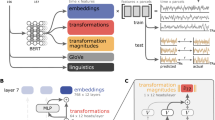Abstract
This paper presents a computational self-organizing model of multi-modal information, inspired from cortical maps. It shows how the organization in a map can be influenced by the same process occurring in other maps. We illustrate this approach on a phonetic – motor association, that shows that the organization of words can integrate motor constraints, as observed in humans.
Preview
Unable to display preview. Download preview PDF.
Similar content being viewed by others
References
Rolls, E.: The Brain and Emotion. Oxford University Press, Oxford (1999)
Burnod, Y.: An adaptive neural network : the cerebral cortex. Masson (1989)
Ballard, D.H.: Cortical connections and parallel processing : Structure and function. The Behavioral and Brain Sciences 9, 67–129 (1986)
Ito, M.: The cerebellum and neural control. Raven, New-York (1984)
Mountcastle, V.B.: An organizing principle for cerebral function. The unit module and the distributed system. In: The mindful brain. MIT Press, Cambridge (1978)
Doya, K.: What are the computations in the cerebellum, the basal ganglia, and the cerebral cortex. Neural Networks 12, 961–974 (1999)
Kohonen, T.: Self-Organization and Associative Memory. Springer, Heidelberg (1988)
Willshaw, D.J., von der Malsburg, C.: How parrerned neural connections can be set up by self-organization. In: Proceedings of the royal society of London, vol. B 194, pp. 431–445 (1976)
Kohonen, T., Oja, E.: Visual feature analysis by the self-organising maps. Neural Computing and Applications 7, 273–286 (1998)
Kohonen, T.: The neural phonetic typewriter. Computer 21, 11–22 (1988)
Miikkulainen, R., Bednar, J.A., Choe, T., Sirosh, J.: Self-organization, plasticity, and low-level visual phenomena in a laterally connected map model of the primary visual cortex. In: Goldstone, R.L., Schyns, P.G., Medin, D.L. (eds.) Psychology of Learning and Motivation (36: perceptual learning), pp. 257–308. Academic Press, San Diego (1997)
Ritter, H., Martinetz, T., Schulten, K.: Neural Computation and Self-Organizing Maps: An Introduction. Addison-Wesley Longman Publishing Co., Amsterdam (1992)
Allard, T., Clark, S.A., Jenkins, W.M., Merzenich, M.M.: Reorganization of somatosensory area 3b representations in adult owl monkeys after digital syndactyly. J. Neurophysiol. 66, 1048–1058 (1991)
Bach-y-Rita, P.: Tactile sensory substitution studies. Ann. NY Acad. Sci. 1013, 83–91 (2004)
Pulvermüller, F.: The Neuroscience of Language. Cambridge University Press, Cambridge (2003)
Ménard, O., Frezza-Buet, H.: Rewarded multi-modal neuronal self-organization: Example of the arm reaching movement. In: Proc. AISTA (2004)
Ménard, O., Frezza-Buet, H.: Multi-map self-organization for sensorimotor learning: a cortical approach. In: Proc. IJCNN (2003)
Amari, S.I.: Dynamical study of formation of cortical maps. Biological Cybernetics 27, 77–87 (1977)
Taylor, J.G.: Neural networks for consciousness. Neural Netowrks 10, 1207–1225 (1997)
Guigon, E., Dorizzi, B., Burnod, Y., Schultz, W.: Neural correlates of learning in the prefrontal cortex of the monkey: A predictive model. Cerebral Cortex 5, 135–147 (1995)
Grossberg, S.: Adaptative pattern classification and universal recoding, i: parallel development and coding of neural feature detectors. Biological Cybernetics 23, 121–134 (1976)
Author information
Authors and Affiliations
Editor information
Editors and Affiliations
Rights and permissions
Copyright information
© 2005 Springer-Verlag Berlin Heidelberg
About this chapter
Cite this chapter
Ménard, O., Alexandre, F., Frezza-Buet, H. (2005). Towards Word Semantics from Multi-modal Acoustico-Motor Integration: Application of the Bijama Model to the Setting of Action-Dependant Phonetic Representations. In: Wermter, S., Palm, G., Elshaw, M. (eds) Biomimetic Neural Learning for Intelligent Robots. Lecture Notes in Computer Science(), vol 3575. Springer, Berlin, Heidelberg. https://doi.org/10.1007/11521082_9
Download citation
DOI: https://doi.org/10.1007/11521082_9
Publisher Name: Springer, Berlin, Heidelberg
Print ISBN: 978-3-540-27440-7
Online ISBN: 978-3-540-31896-5
eBook Packages: Computer ScienceComputer Science (R0)




